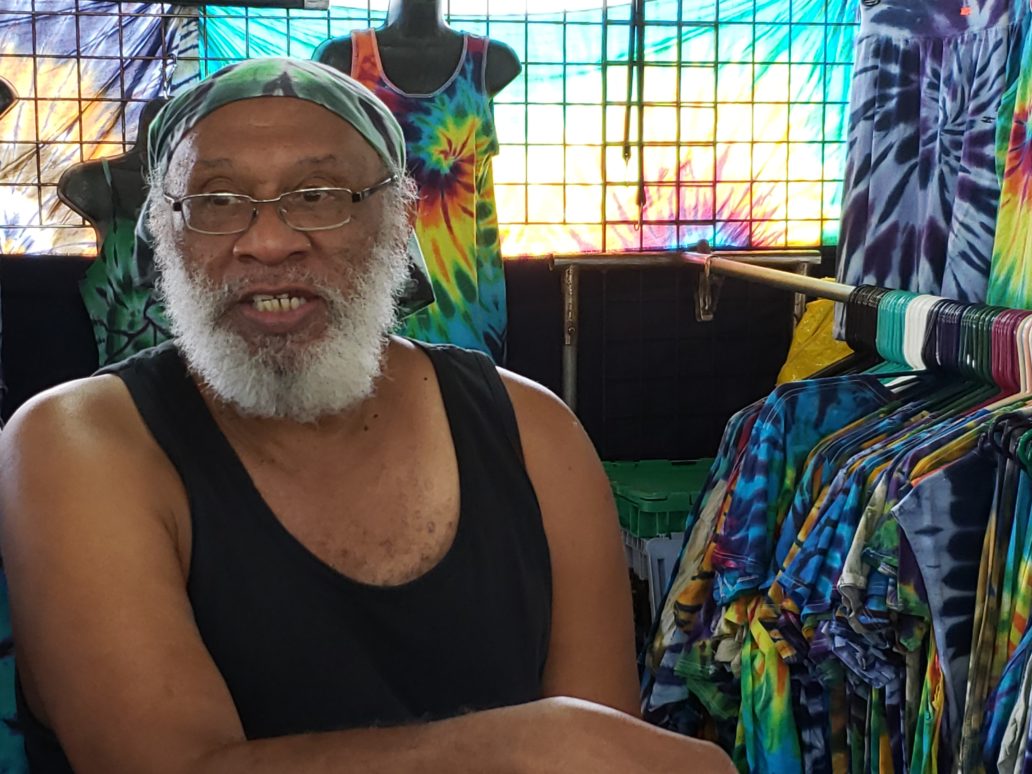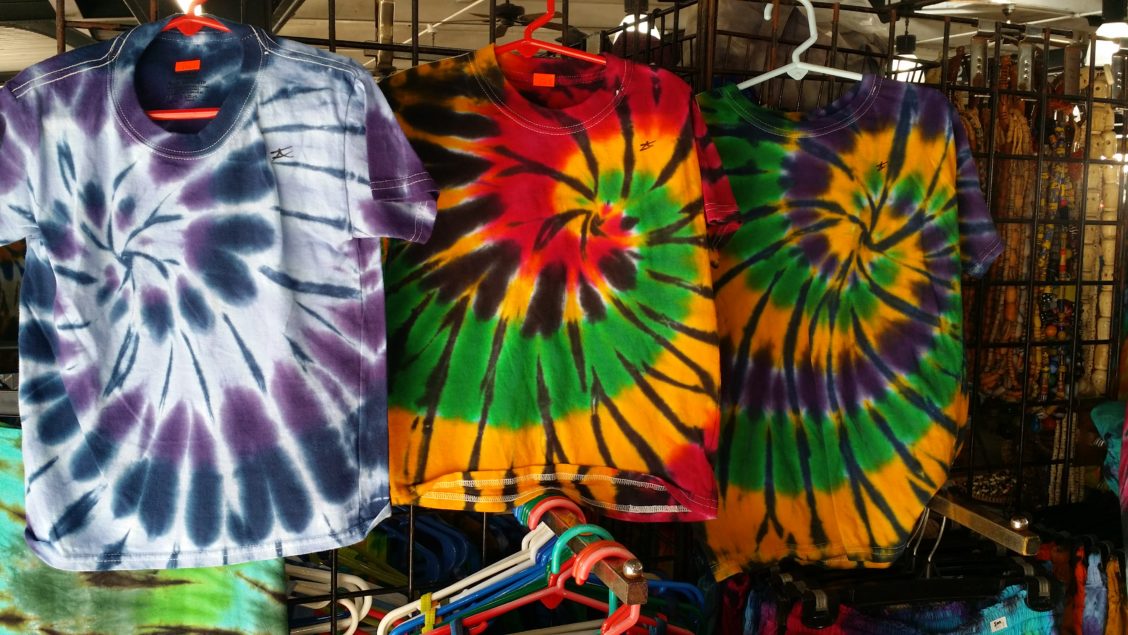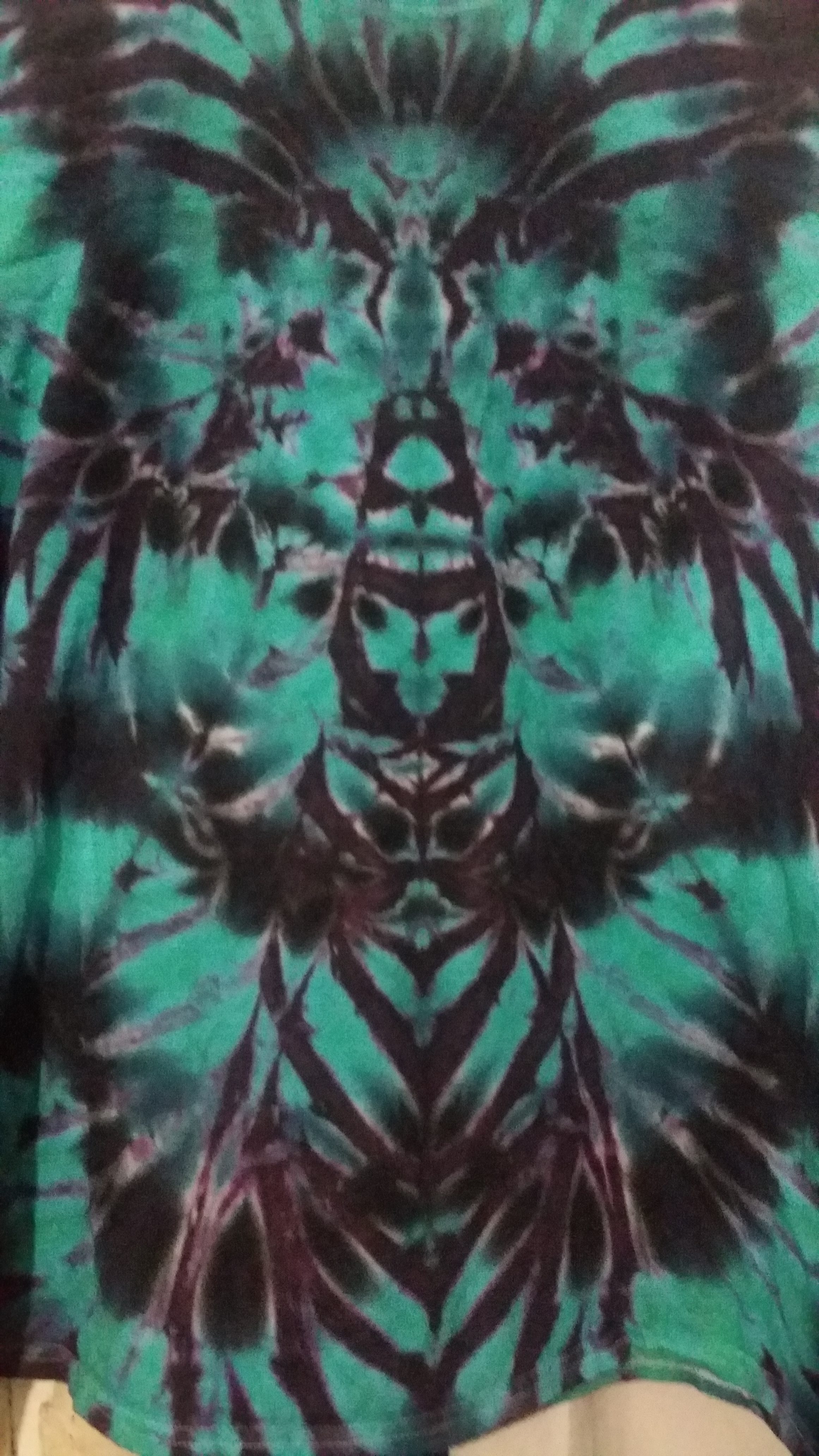
Zahdan Sterling with his work. (Photo by: Lacar Musgrove)
Zahdan, in an apron and green rubber gloves, is telling me about the 1993 DJ Jubilee video “Back that Thang Up,” a classic of New Orleans bounce music. Among the exuberant crowd shown dancing in the summer heat are a few women wearing brightly-colored tie-dyed shirts. Zahdan says those are his shirts, or at least those are shirts he made, and that video significantly increased the demand for that style. “So I was making a lot of Eruptions back then,” he says. “Eruption is the only one that really works in bright colors like that. It’s the only one with no black in it.”
While Zahdan works at one of the two worktables in the small, cluttered room, Greg sits on the other. He folds his skinny legs against his chest, crossing them at the ankles, and hooks his elbows over his knees with one hand clutching the other wrist, gargoyle-like. Greg introduced Zahdan to the art of tie-dye in 1988. He’s in town this week by chance, and his presence for this interview is eerily serendipitous. As Zahdan tells his story, Greg flicks his eyes between him and the TV in the corner, occasionally chiming in with some detail or correction.
Between the two of them, I’m perched on a stool, the felt tip of my pen whispering urgently along the blue lines of my little notebook. Zahdan’s narrative jumps around in time and space, dragging me along rambling digressions that lead back to the answer to my question long after I have forgotten what my question was.
“That critter right there. . . ” he says, pointing to a t-shirt that hangs on the wall beside the front door. In the pattern, yellow and black lines radiate spider-like from the bottom, forming the shape of a cauldron. “Submergence, the neon ting, is the explanation of the mystical side of it.” The Submergence, with its upward lines, he tells me, represents the Yin, the feminine, water. The Emergence, curving down, represents the Yang, masculine, fire.
Getting up from the table and walking across the room, he points to the converging lines in the center of the design. “I call this ‘The content of our conflict.’ There’s always images. There’s a face, a head, and a body and arms, and there’s legs. See how these lines come down? There’s always a way out of a Submergence.”
Pointing with a long wooden dowel he instructs me on the meaning of the patterns in the authoritative manner of a philosopher instructing a student. I get the idea when he is telling me these things that if I don’t understand it’s because I’m not looking hard enough, not listening. He asks me, “Do you see? Do you see it?” He looks expectantly at me and waits for my answer.
Zahdan’s tie-dyes tell stories, he says. “I get to write on fabric. I consider myself an alchemist.”
Earlier, the Fed Ex man delivered two large boxes, a shipment of the white t-shirts, pants, dresses, and skirts Zahdan uses as writing paper. He flips open the box to reveal stacks of pure, crisp cotton textile. Motioning again to the Submergence hanging on the wall, he says, “Did I tell you I’m also a fabric warrior? I hunt the wild whites and whip ‘em into color? That’s what I do. They come into my house this way and they leave my house that way.”

Tie-dye t-shirts of Zahdan Sterling. (Photo: Zhadan Sterling)
On the Friday before Mardi Gras, Zahdan invited me over for dinner. He said he had a bowl of split pea soup and a present for me. We live in the same neighborhood in New Orleans, an old suburb of the French Quarter, downriver along the Mississippi, known as the Bywater. Our homes are on opposite ends — his on the upriver side, by the railroad tracks, and mine on downriver side, by the Industrial Canal. The trip from my house to his, by swiftly peddled bike, takes nearly ten minutes.
Arriving under the pink late-afternoon sky, I mounted the concrete stoop and rapped on the glass pane in the front door. I could see into the front room of the shotgun house, his workshop, where a baker’s rack stacked with gleaming white clothes stood next to an old fireplace mantle on the wall opposite a work table and a wooden shelf laden with plastic bottles full of dye. He came out and opened the side gate. I rolled my bike through the narrow alley along the house into the lush back garden. On a previous visit, I had found the backs of plastic chairs draped with freshly dried tie-dyes. From the little shed in the back of the garden, the dryer buzzer had sounded. Another batch ready to go.
When I stepped through the French doors that separate the back porch from the tiny kitchen, Zahdan was standing at the stove frying a pan of venison. He had never cooked venison like this before, and had called his mother to ask how. She told him to soak it overnight in vinegar, which he did, and to cook it for two hours, which he did not intend to do. “My mother cooks everything too long. She’ll cook a pot of green beans for two hours. ‘Mama,’ I told her, ‘they’ll cook in fifteen minutes.’”
I dropped my bag on the floor and peeled off my tight fitting leather jacket. After weeks of unseasonably warm weather, it was getting cold, and I was wearing layers. Zahdan told me to make myself at home and offered me a drink. I laughed. I was still recovering from a round of Carnival parades the night before.
“All right, then, take your time.”
Zahdan complains that his sacrifice, if he can call it that, is that while everyone else is partying for Mardi Gras, he’s working, dying clothes and selling them at his booth at the French Market, catching the big wave of tourists.

Intricate patterning of tie-dye shirts. (Photo by: Zahdan Sterling)
When he first moved to New Orleans, in 1990, Zahdan was still a lanky man with big glasses, a black beard, and a full head of black dreadlocks. Now, almost twenty years later, his features have softened and his belly has rounded. His wire-rimmed glasses rest on his nose mid-bridge, his beard is grey, a tie-dye bandana tied over his long grey locks. He punctuates his speech, crackling in a gentle drawl, with a sweet, warm chuckle that is almost grandmotherly.
He walked past me where I sat at the little kitchen table into the living room. From behind a pile on a shelf he pulled out a long sleeve t-shirt. “I made it like you asked: red, grey, and black, right?”
The long sleeve t-shirt he handed me had been dyed in a spiral pattern — the one that looks like the backs of people in robes standing in a circle — a gift promised as a thank you for helping him with his Jazz Fest application. He had sold tie-dyes there in years before, but, times being so conveniently technological as they are, vendor applications now require properly formatted digital photographs and a level of internet savvy that a fifty-six-year-old artisan does not likely possess. With the help of me and a couple of other friends, though, Zahdan and his tie-dyes would be back at the Fest.
I had met Zahdan one evening the previous summer when I accompanied a friend to a small birthday party for her friend’s child. When we arrived, the party was wrapping up, and the adults were drinking beer on the front porch. Zahdan, never hesitant or circumspect, demanded my conversation, solicited my friendship, and instructed me to call him “Z.”
It was clear to me that his initial interest in my person was based entirely on my being an attractive young woman. But I humored him. Before the night was over, in a logistical complication I’m still confused about, I found all one-hundred pounds of my little white self driving this rotund black man’s huge, growling Bronco through the neighborhood to his house, while he drove his van. Considering that I’d had a few beers, I was surprised at the amount of faith he was putting in me to pilot what felt, after driving around in my little compact car, like a small warship through the narrow streets of the Bywater.
As I sat at the table examining the spiral of red and grey, he stood at his stove with one hand resting on his lower back and the other on the handle of the cast iron skillet, shaking onions and celery around in the oil which sizzled with brown lumps of fresh, sinewy venison.
“Where’d you get the deer?”
“Oh, a lot of people hunt deer on our land.”
Northwest of New Orleans and Baton Rouge along the Mississippi River, Point Coupee Parish is French Creole plantation country. Dan Sterling, now known as “Zahdan,” grew up in there on a narrow fifty-acre strip of land, once a part of the Argyle Plantation, on Bayou Lafouche. His father first rented the land in 1940–when the oldest of his five siblings was born–then bought it in 1965. This was the land where his ancestors had lived as slaves. His mother still lives there with Loraine, one of his four sisters, who moved back from New Orleans after divorcing her husband in 1990. Zahdan left home for college in 1968, but in 1984 he moved into his grandmother’s house in Pointe Coupee to help care for his father who, after suffering many years with Parkinson’s Disease, died in 1987.
Despite my ambivalence toward the introduction of tie-dye into my regular wardrobe, I pulled the long sleeve shirt over my other layers, grateful for the extra warmth on my way to another round of parades on a cold night. Once I had it on, I have to say, the pattern worked its charm.
“You wouldn’t be the first one I converted,” said Zahdan with a chuckle.
Lacar Musgrove is a writer, editor, and cultural historian from Louisiana who has resided in New Orleans for 12 years. She is a graduate of the MFA in Creative Writing program at the University of New Orleans and also has an MA in History from UNO. Her work has been featured in Louisiana Cultural Vistas, Boneshaker Magazine, WWNO’s Storyville: Voices from the University of New Orleans, and Factorialist.com. You can find more of her work at her website, LacarMusgroveEditor.com. Her “Fabric Warrior” series will be running on ViaNolaVie every Monday.
 NOLAbeings Multimedia artist Claire Bangser created NOLAbeings as a portrait-based story project that marries...
NOLAbeings Multimedia artist Claire Bangser created NOLAbeings as a portrait-based story project that marries...  Voodoo in New Orleans: Reviving history: New Orleans fortune telling This article takes a deep dive into the history of Voodoo in New Orleans, its hybridization with Catholicism, and its present-day place in the city's culture. The author visits fortune-tellers in the French Quarter, using their guidance as a tool for introspection rather than a deterministic predictor of the future. Through her experiences in New Orleans, the author feels a mystical connection to both the past and the future.
Voodoo in New Orleans: Reviving history: New Orleans fortune telling This article takes a deep dive into the history of Voodoo in New Orleans, its hybridization with Catholicism, and its present-day place in the city's culture. The author visits fortune-tellers in the French Quarter, using their guidance as a tool for introspection rather than a deterministic predictor of the future. Through her experiences in New Orleans, the author feels a mystical connection to both the past and the future. 
[…] can also read part I, part II, and part III of “Fabric […]
[…] To read Part I of “Fabric Warrior: Zahdan Sterling,” click here. […]